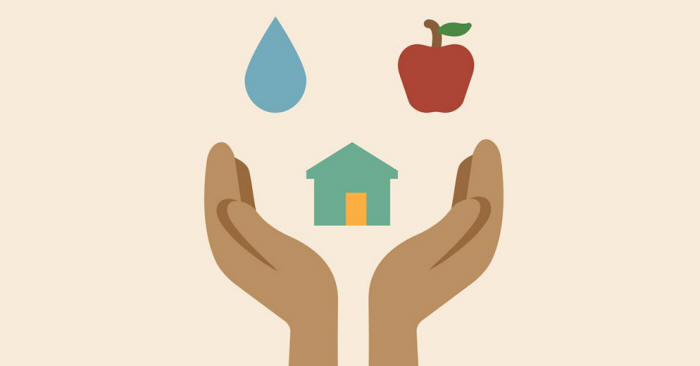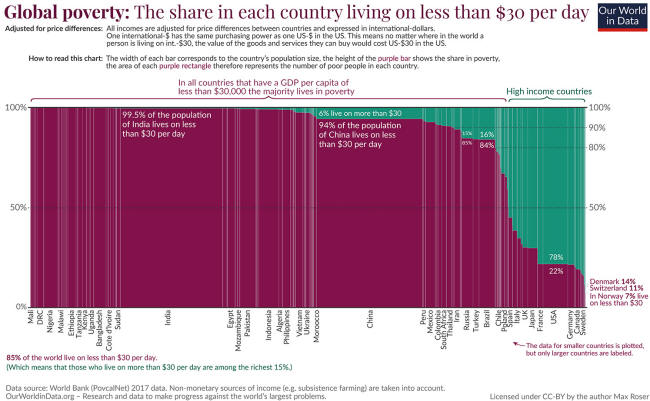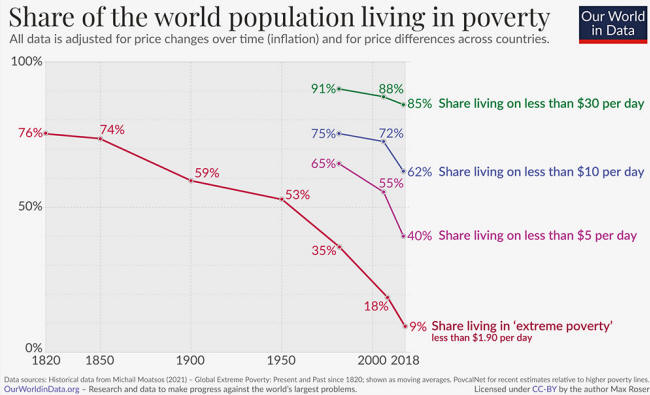|

by Max Roser
January 11,
2022
from
OurWorldInData Website

The
decline of global poverty
is one of the
most important
achievements in
history,
but the end of
poverty
is still very
far away...
The Reverend
Thomas Malthus asserted that poverty is inevitable.
"It has appeared that
from the inevitable laws of our nature, some human beings must
suffer from want. These are the unhappy persons who, in the
great lottery of life, have drawn a blank." 1
Writing in the 18th
century it is understandable that he came to this conclusion.
Poverty was such a persistent reality in humanity's history up to
then, that it was unimaginable that it could ever be different.
In the two centuries since Malthus' death we have learned however
that he was wrong.
The deep poverty of the past is not inevitable.
Economic growth is
possible and entire societies can leave the widespread poverty of
the past behind.
It is possible
to leave widespread poverty behind
Let's look at one of the societies that has achieved this.
Two centuries ago, the
huge majority of people in Sweden lived in deep poverty.
Every
fourth child died,
and close to 90% of the population was so very poor that they could
not afford a tiny space to live, some minimum heating capacity, and
food that would not induce malnutrition. 2
Adjusted for inflation the income distribution looked like this:
3

From the late 19th century onwards Sweden's economy increasingly
adopted modern production technology and achieved the productivity
gains that made economic growth possible.
A century ago Swedes were
still poor, but the majority had left the very worst poverty behind.
4

Today the poverty line in Sweden is set at about $30 per day (this
is adjusted for price differences between countries and measured in
international-dollars). 5
The
strong economic growth in the last century made it possible that
the majority of Swedes are living above the poverty line. 6

Sweden is one of the countries that achieved large growth and
thereby proved Malthus wrong.
The three distributions
show how the majority of Swedes left the deep poverty of the past
behind.
The majority
of the world is poor
Other high-income countries adopted poverty lines very similar to
Sweden's poverty line of $30 a day.
And
as I documented before, the
size of social care payouts and proposals for Universal Basic
Incomes are also around $30 per day.
Just like the UN relies
on the $1.90 per day poverty line to track 'extreme poverty', I
therefore rely on the $30 a day threshold as a definition for
'poverty'.
It is based on the notion
of who is considered poor in the world's richer countries.
Taking into account the different price levels across countries, the
latest statistics show that 85% of the world population live below
this poverty line.
This large visualization shows where they live.
The height of the purple bar corresponds to the share in poverty in
each country.
I ordered the countries by income:
from the poorest
countries on the very left to the richest countries on the
right.
The width of each country
corresponds to the country's population size.
The only countries in which not nearly everyone lives in poverty are
high-income countries. GDP per capita is a measure of average income
that not only takes people's individual incomes, but also government
expenditure, into account. 7
As noted in the chart, in
all countries that have a GDP per capita of less than $30,000 the
majority of the population lives in poverty.
But the data also shows that in all countries a significant share
lives in poverty. No country, not even the richest countries, has
eliminated poverty.
There are no 'developed'
countries, there is work to do for all.

How far away
are we from a world in which no one lives on less than $30 a day?
The economic history of today's richest countries shows that
widespread poverty is not inevitable.
What needs to happen to
achieve the same for all people in the world?
The share in poverty in any country depends on two factors: the
average level of income and the level of inequality.
Some
countries
reduced inequality successfully and thereby reduced
poverty. Lower inequality in the future can further reduce
poverty.
But because
the average income in the majority of countries in the world
is much lower than $30-poverty-line, strong growth is
necessary for global poverty to decline.
I calculated
that at a minimum the world economy needs to increase
five-fold for global poverty to substantially decline.
This is in
a scenario in which the world would also achieve a massive
reduction in inequality: inequality between all the world's
countries would disappear entirely in this scenario.
It should
therefore be seen as a calculation of the minimum necessary
growth for an end of poverty.
A five-fold
increase of the global economy is certainly not easy to
achieve, but it is also not impossible - it is what the
world has achieved
in the last 5 decades, and the climate researchers of
the IPCC
expect even more growth for this century in their
'Sustainability Scenario', the scenario in which the world
is most successful in avoiding climate change.
8
That all of
the world will live on more than $30 a day might be hard to
imagine right now.
But then
it's good to remember that today's reality in high-income
countries was also entirely unimaginable very recently.
Two
centuries of progress and still a very long way to go
The final
chart summarizes the global history of poverty. It focuses
on the last two centuries when humanity
left the stagnation of the past behind and achieved
growth for the first time.
The world
made good progress - in the last decade the share that lives
on less than $10 per day has declined by 10 percentage
points - but the chart also shows that much progress is
still needed. 62% live on less than $10 per day and 85% live
on less than $30.
The global
data makes clear why the world needs much more growth to end
poverty. The world as a whole today is in a situation not so
different from Sweden a century ago.
The majority of the
world left extreme poverty behind, but is still far poorer
than $30 a day.
Even after
two centuries of the global fight against poverty we are
still in the early stages. The history of global poverty
reduction has only just begun.

Our World in
Data presents the data and research to make progress against the
world's largest problems.
This article draws on data and research discussed in our entry
on
Global Poverty...
Endnotes
-
Thomas
Malthus (1798) - An Essay on the Principle of Population.
Chapter X, paragraph 29, lines 12-15. Online
here.
-
Michail
Moatsos (2021) - Global extreme poverty: Present and past
since 1820. Published in OECD (2021), How Was Life?
Volume II: New Perspectives on Well-being and Global
Inequality since 1820, OECD Publishing, Paris,
https://doi.org/10.1787/3d96efc5-en.
-
The data
for the income distribution plotted below is produced by the
team of Gapminder - it is documented
here.
-
Moatsos
estimates that in 1920 a third of Sweden's population (34%)
still lived in extreme poverty.
-
Sweden's
median monthly income in 2017 was $1469 according to
PovcalNet. 60% of the median expressed in daily
income/consumption is (0.6*1469)/30=$29.38 per day
-
Much of
this progress was achieved in the recent past, since the
early 80s the share living on less than $30
has declined from 60% to 16%.
-
GDP per
capita is a more comprehensive measure of average incomes
and there are several reasons why it is typically higher
than the averages found in both income surveys and
expenditure surveys.
GDP
includes many items that are typically not measured in
household income surveys, such as an imputed rental value of
owner-occupied housing, the retained earnings of firms and
taxes on production such as VAT.
The gap is even larger when
GDP is compared to surveys of household consumption - the
latter concept excluding both investment expenditure and
government expenditure on public services such as education
and health.
Other
aggregates beyond GDP are available in the national accounts
that are more comparable to the concepts applied in
household income and consumption surveys.
However, important
differences still remain even here.
For example, in addition
to imputed rents, imputations for the value of certain
financial services, such as bank accounts, are included in
aggregate household consumption measured in national
accounts, with no equivalent for these items recorded in the
survey data. In many countries the consumption of 'nonprofit
institutions serving households' (NPISH) is included as part
of household consumption within national accounts, but not
within household surveys.
On top of
these conceptual differences are a range of mis-measurement
problems that affect both sets of data. On this topic see
Deaton (2005), and Pinkovskiy and Sala-i-Martin (2016).
Deaton,
Angus. 2005. "Measuring Poverty in a Growing World (or
Measuring Growth in a Poor World)." The Review of Economics
and Statistics 87 (1): 1–1.
Pinkovskiy,
Maxim, and Xavier Sala-i-Martin. 2016. "Lights, Camera…
Income! Illuminating the Nation"
-
In this
scenario global GDP per capita increases to $81,250.
|







